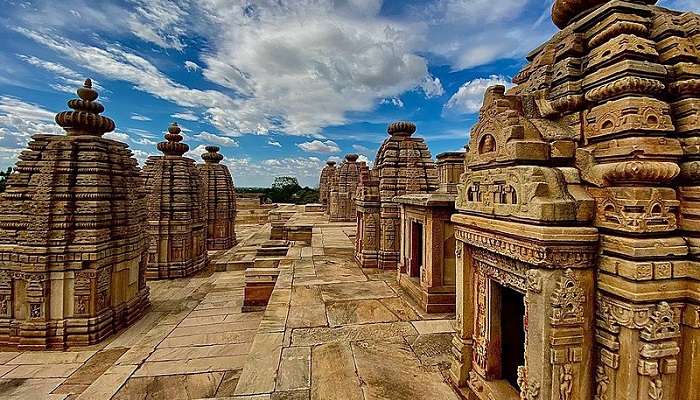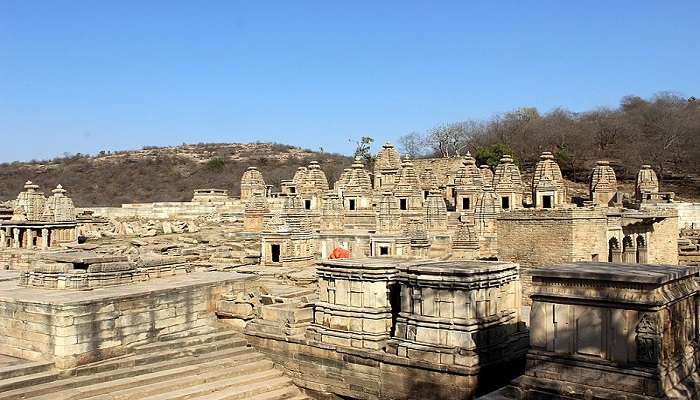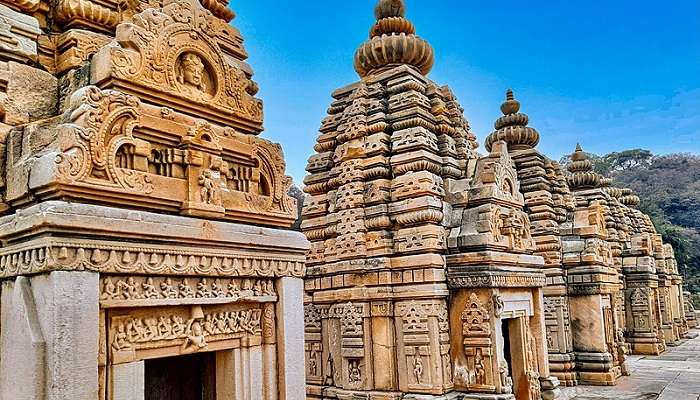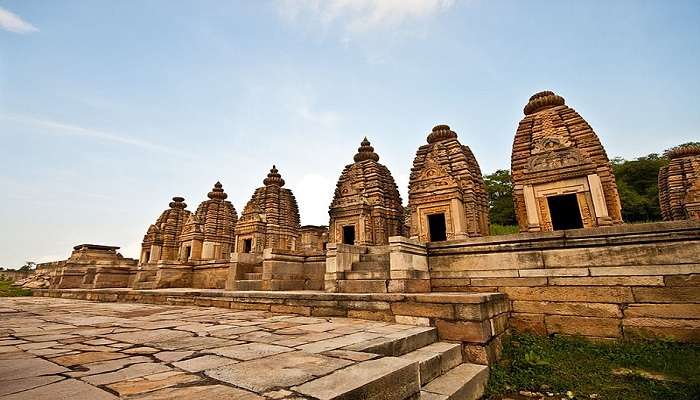Visit The Bateshwar Group Of Temple’s Morena In Madhya Pradesh In 2026

Hidden in the rugged ravines of Madhya Pradesh lies a remarkable archaeological treasure – the Bateshwar Group of Temple’s Morena. This vast complex of over 200 ancient shrines near Morena City offers a fascinating glimpse into India’s rich architectural heritage. Dating back to the 8th-11th centuries CE, these sandstone temples dedicated to Lord Shiva and other Hindu deities showcase elaborate carvings and diverse architectural styles that have withstood the test of time. The temples are spread across a picturesque 10-hectare site along the Chambal River, showcasing Nagara and Pratihara architectural styles. The rediscovery of the Bateshwar temple complex in recent decades has sparked a renewed interest in this archaeological wonder.
About Bateshwar Group of Temple’s Morena

The Bateshwar Group of Temples in Morena in Madhya Pradesh is a fascinating collection of nearly 200 Hindu temples, most dating back to the 8th-10th centuries. Carved from sandstone in the early Gurjara-Pratihara style of North Indian temple architecture, these temples are a testament to the artistic and religious heritage of the region. The Bateshwar complex is a unique sight spread over 25 acres on the northwestern slope of a hill near Padavali village. Though mostly small, the temples represent the three major Hindu traditions—Shiva, Vishnu, and Shakti. The Bhuteshvar Temple, the largest dedicated to Shiva, is thought to be the origin of the site’s name, Bateshwar.
Unfortunately, time and invaders haven’t been kind to the Bateshwar temples. Many have been reduced to ruins. However, since 2005, the Archaeological Survey of India has undertaken a project to reconstruct and restore these historical monuments. This ongoing effort is helping to preserve this significant piece of Indian history. If you’re interested in ancient art, history, or Hinduism, the Bateshwar Group of Temples is a worthwhile destination.
Must Read: Laxmi Temple Orchha
History Of Bateshwar Group of Temple’s Morena

The Bateshwar Group of Temples in Morena was built during the Gurjara-Pratihara dynasty, around the 8th to 10th centuries AD, though some parts may date back to 600 AD. The architecture of these temples evolved. The earliest temples had simple square roofs, while later ones featured more intricate conical roofs called “Mandapika Shrines.” These shrines reflect the core elements of Hindu temple architecture and show the artistic development of that period. The detailed carvings on some temples suggest they may have even older influences. The temples were built during the prosperous times of the Gurjara-Pratihara dynasty. They were dedicated to the Hindu gods Shiva, Vishnu, and Shakti, making the complex an important worship centre. However, as the dynasty declined, the temples were abandoned and became overgrown by the jungle.
1882, British archaeologist Alexander Cunningham rediscovered the ruins, bringing them back into historical awareness. Many scholars, including French archaeologist Odette Viennot in 1968, studied the site and documented the temples. In 2005, the Archaeological Survey of India (ASI) began a major restoration project led by K.K. Muhammed, the Superintending Archaeologist of the Bhopal region. Muhammed’s efforts led to the restoration of about 60 temples, ensuring the preservation of Bateshwar’s cultural and historical legacy for future generations.
The Architecture Of Bateshwar Group Of Temple’s Morena

The Bateshwar site, historically referred to as Dharon or Paravali and later as Padavali, is locally known as the Batesvar or Bateshwar Group of Temple’s Morena. This Bhutesvara temple had a square sanctum measuring 6.75 feet (2.06 m) per side, with a modest 20 square feet maha mandapa. The river goddesses Ganga and Yamuna flanked the sanctum’s doorway. The tower’s superstructure was a pyramidal square, starting from a 15.33 feet (4.67 m) sided square base and tapering rhythmically upwards.
The temples’ walls were constructed from upright single slabs, topped with flat roofs and pyramidal peaks. The site also featured a water tank carved into the hill rock, with a row of small temples arranged along a street leading to the tank. A Shiva linga, a Trimurti statue, and Ganesha, Shiva, and Parvati sculptures were also found in the temples. Adjacent to the Shiva temple was a Vishnu temple, similar in size to the Shiva temple, with a square sanctum measuring 6.67 feet (2.03 m) per side and the river goddesses Ganga and Yamuna flanking its doorway. In the north-northeast corner of the site was a large platform, approximately 42.67 feet (13.01 m) long and 29.67 feet (9.04 m) wide, with a projection of a square platform of 11.67 feet (3.56 m) per side.
Suggested Read: Chaturbhuj Temple
Best Time To Visit

Choosing the ideal time to visit the Bateshwar Group of Temple’s Morena is essential to fully appreciate this wonder. It is as follows:
- October to March: This is the best time to visit Bateshwar. The scorching summer heat subsides, giving way to comfortable temperatures ranging from 15°C to 30°C (59°F to 86°F). This pleasant weather makes exploring the expansive complex much more enjoyable.
- Shivratri (February/March): If you’d like to witness the temples during a vibrant celebration, plan your visit around Shivratri. This Hindu festival dedicated to Lord Shiva sees the temples come alive with special prayers, offerings, and a festive atmosphere.
- Avoiding Monsoon: The monsoon season in Morena arrives around July and lasts until August. While the rains bring much-needed respite from the summer heat, they can make exploring the temples challenging due to slippery paths and potential flooding in the ravines.
How To Reach

There are various ways to reach the Bateshwar Temple Complex in Morena. The ways are:
By Road
The temple complex is approximately 35 km from Gwalior and 30 km from Morena Railway Station. Rent a vehicle from Gwalior to explore the Bateshwar Sanctuary Perplexing and nearby locales like Padavali and Mitawali.
By Road
The nearest railway station is Morena, situated roughly 30 km away from the Bateshwar Group of Temple’s Morena. You can hire a taxi or private car from Morena to reach the temple complex.
By Air
If you plan to visit the Bateshwar Group of Temples in Morena, Madhya Pradesh, the nearest airport is Gwalior Airport. From there, you can easily arrange for a taxi or private car to take you to Bateshwar.
Further Read: Shri Ram Raja Mandir
The Bateshwar Group of Temples in Morena, India, have beautiful carvings and are important to history. Whether you’re curious about history or seeking spiritual experiences, exploring these beautifully restored marvels is highly recommended. Don’t miss the opportunity to explore this architectural wonder and discover other cultural treasures in Madhya Pradesh! Book your trip to Madhya Pradesh today and embark on an unforgettable journey through time and tradition!
For our editorial codes of conduct and copyright disclaimer, please click here.
Cover Image Source: Shailparihar13 for Wikimedia Commons
Frequently Asked Questions About Bateshwar Group of Temple’s Morena
Who built the Bateshwar temple in Morena?
The Bateshwar Temple complex, also known as Batesara or Batesvar, is located in the Morena district of Madhya Pradesh. These ancient temples were built during the 8th to 10th century AD by the Gurjara-Pratihara dynasty. The Pratihars, who considered themselves descendants of Lakshman from the epic Ramayana, ruled a significant part of northern India during that period.
How many temples are there in Bateshwar?
The Bateshwar complex is massive, containing nearly 200 temples. These temples are mostly small shrines spread out over 25 acres. Unfortunately, many of the temples are in ruins today.
What is the history of Bateshwar?
The Bateshwar Temple complex lies within the densely forested ravines of the Chambal Valley. Despite its grandeur, historical records about these temples are scarce. The earliest reference comes from Alexander Cunningham, who explored the region in the late 19th century. He described the temple complex as “a confused assemblage of more than 100 temples, large and small,” with the main Bhuteshwar Temple standing out. The intricate carvings and craftsmanship reveal the rich heritage of this site.
Who is the god of Bateshwar temple?
The Bateshwar temples are dedicated to various Hindu gods and goddesses. However, a significant number of temples are specifically dedicated to Shiva, Vishnu, and Shakti, representing the three major Hindu traditions.
Who broke the Bateshwar temple?
Unfortunately, the Bateshwar Temple complex suffered neglect and gradual decline over the centuries. While nature reclaimed parts of it, the remaining structures continue to evoke awe. The site’s serene ambience, surrounded by lush greenery and the Chambal River, adds to its mystique. As for who broke the Bateshwar temple, history remains silent on any specific event or individual responsible for its eventual decay.
People Also Read:
Champavati Temple Someshwar Mahadev Temple Kalyani Devi Temple

As a Travel Content Writer, I live to conquer the world of globetrotting with words. With my unquenchable thirst for storytelling, I believe that my words will inspire you to travel around the world’s breathtaking landscapes. As for me, I am an unapologetic selenophile, who loves to wander around in a starry night!











